Consumer Behavior in Tourism: Insight Vacations Case Study Report
VerifiedAdded on 2022/12/19
|13
|4553
|409
Report
AI Summary
This report provides a comprehensive analysis of consumer behavior within the tourism industry, focusing on Insight Vacations as a case study. It investigates the cultural, social, personal, and psychological factors that influence consumer decisions, and explores how digital technology is reshaping consumer trends. The report examines the stages of the consumer decision-making journey, maps the path to purchase, and evaluates the strategies marketers use to influence these stages, including B2C and B2B approaches. It also analyzes the different approaches to market research and provides a detailed evaluation of how various factors impact tourism decision-making and buying behavior, supported by specific examples, ultimately offering valuable insights into the dynamics of consumer behavior in the tourism sector and how marketers can effectively respond.
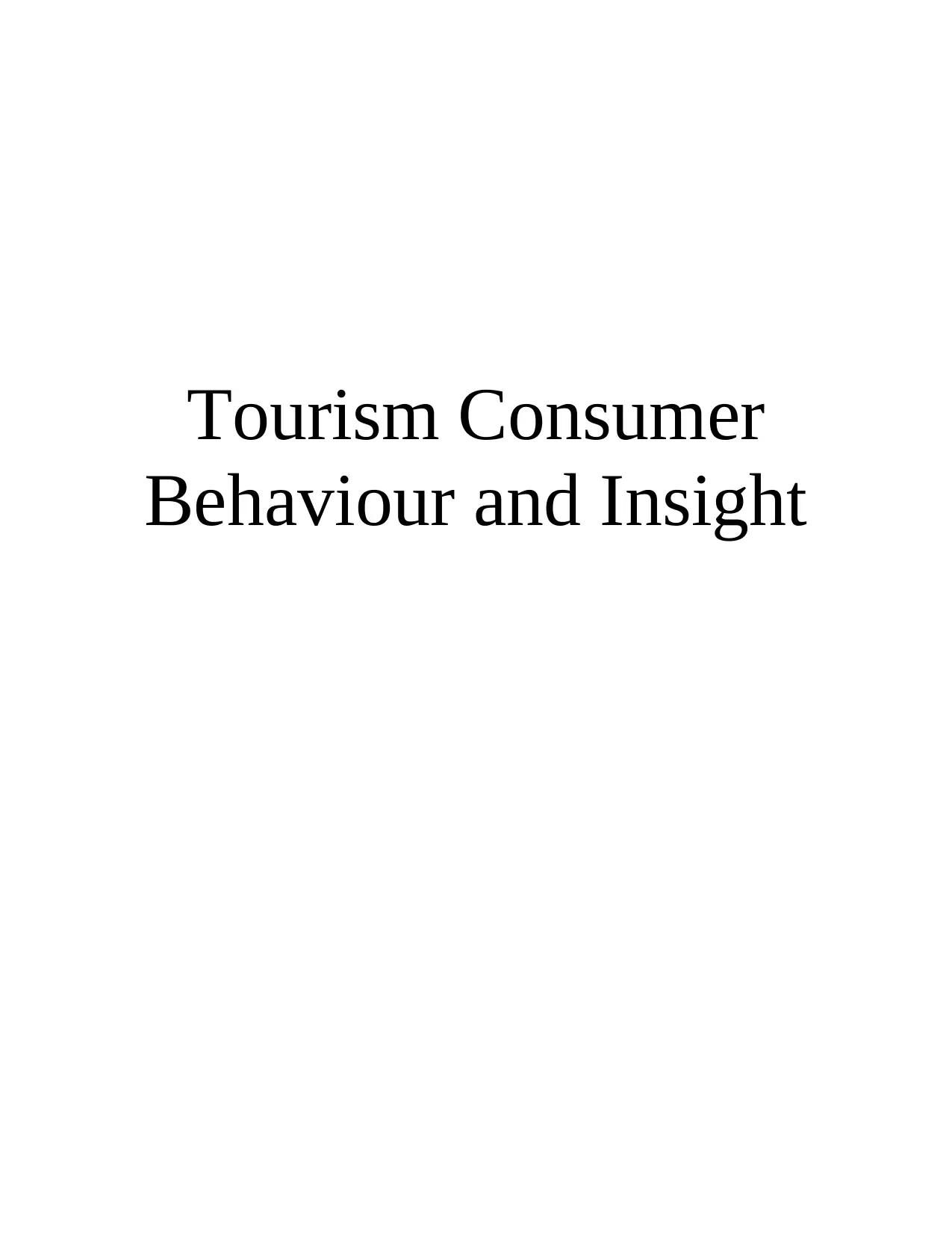
Tourism Consumer
Behaviour and Insight
Behaviour and Insight
Paraphrase This Document
Need a fresh take? Get an instant paraphrase of this document with our AI Paraphraser
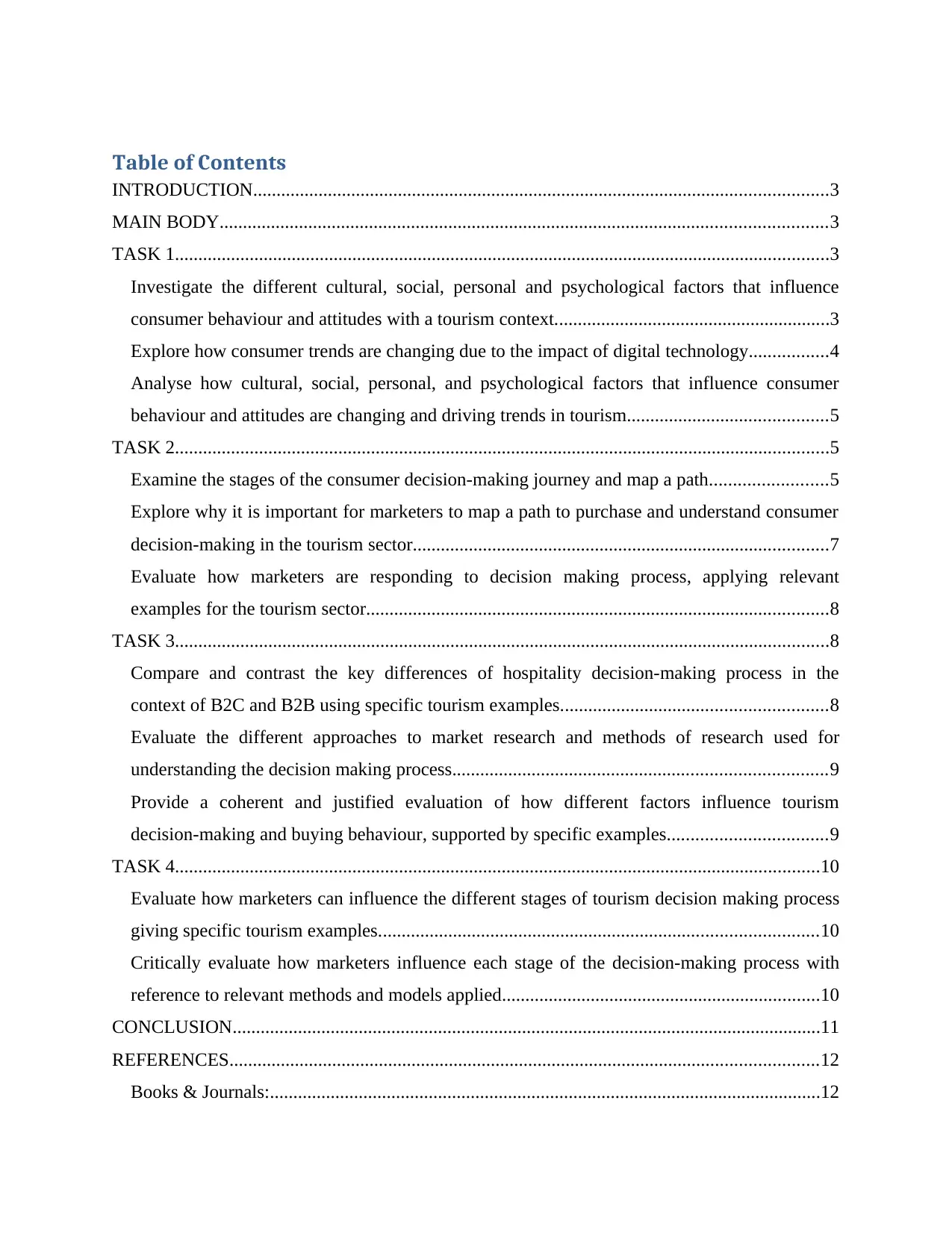
Table of Contents
INTRODUCTION...........................................................................................................................3
MAIN BODY..................................................................................................................................3
TASK 1............................................................................................................................................3
Investigate the different cultural, social, personal and psychological factors that influence
consumer behaviour and attitudes with a tourism context...........................................................3
Explore how consumer trends are changing due to the impact of digital technology.................4
Analyse how cultural, social, personal, and psychological factors that influence consumer
behaviour and attitudes are changing and driving trends in tourism...........................................5
TASK 2............................................................................................................................................5
Examine the stages of the consumer decision-making journey and map a path.........................5
Explore why it is important for marketers to map a path to purchase and understand consumer
decision-making in the tourism sector.........................................................................................7
Evaluate how marketers are responding to decision making process, applying relevant
examples for the tourism sector...................................................................................................8
TASK 3............................................................................................................................................8
Compare and contrast the key differences of hospitality decision-making process in the
context of B2C and B2B using specific tourism examples.........................................................8
Evaluate the different approaches to market research and methods of research used for
understanding the decision making process................................................................................9
Provide a coherent and justified evaluation of how different factors influence tourism
decision-making and buying behaviour, supported by specific examples..................................9
TASK 4..........................................................................................................................................10
Evaluate how marketers can influence the different stages of tourism decision making process
giving specific tourism examples..............................................................................................10
Critically evaluate how marketers influence each stage of the decision-making process with
reference to relevant methods and models applied....................................................................10
CONCLUSION..............................................................................................................................11
REFERENCES..............................................................................................................................12
Books & Journals:......................................................................................................................12
INTRODUCTION...........................................................................................................................3
MAIN BODY..................................................................................................................................3
TASK 1............................................................................................................................................3
Investigate the different cultural, social, personal and psychological factors that influence
consumer behaviour and attitudes with a tourism context...........................................................3
Explore how consumer trends are changing due to the impact of digital technology.................4
Analyse how cultural, social, personal, and psychological factors that influence consumer
behaviour and attitudes are changing and driving trends in tourism...........................................5
TASK 2............................................................................................................................................5
Examine the stages of the consumer decision-making journey and map a path.........................5
Explore why it is important for marketers to map a path to purchase and understand consumer
decision-making in the tourism sector.........................................................................................7
Evaluate how marketers are responding to decision making process, applying relevant
examples for the tourism sector...................................................................................................8
TASK 3............................................................................................................................................8
Compare and contrast the key differences of hospitality decision-making process in the
context of B2C and B2B using specific tourism examples.........................................................8
Evaluate the different approaches to market research and methods of research used for
understanding the decision making process................................................................................9
Provide a coherent and justified evaluation of how different factors influence tourism
decision-making and buying behaviour, supported by specific examples..................................9
TASK 4..........................................................................................................................................10
Evaluate how marketers can influence the different stages of tourism decision making process
giving specific tourism examples..............................................................................................10
Critically evaluate how marketers influence each stage of the decision-making process with
reference to relevant methods and models applied....................................................................10
CONCLUSION..............................................................................................................................11
REFERENCES..............................................................................................................................12
Books & Journals:......................................................................................................................12
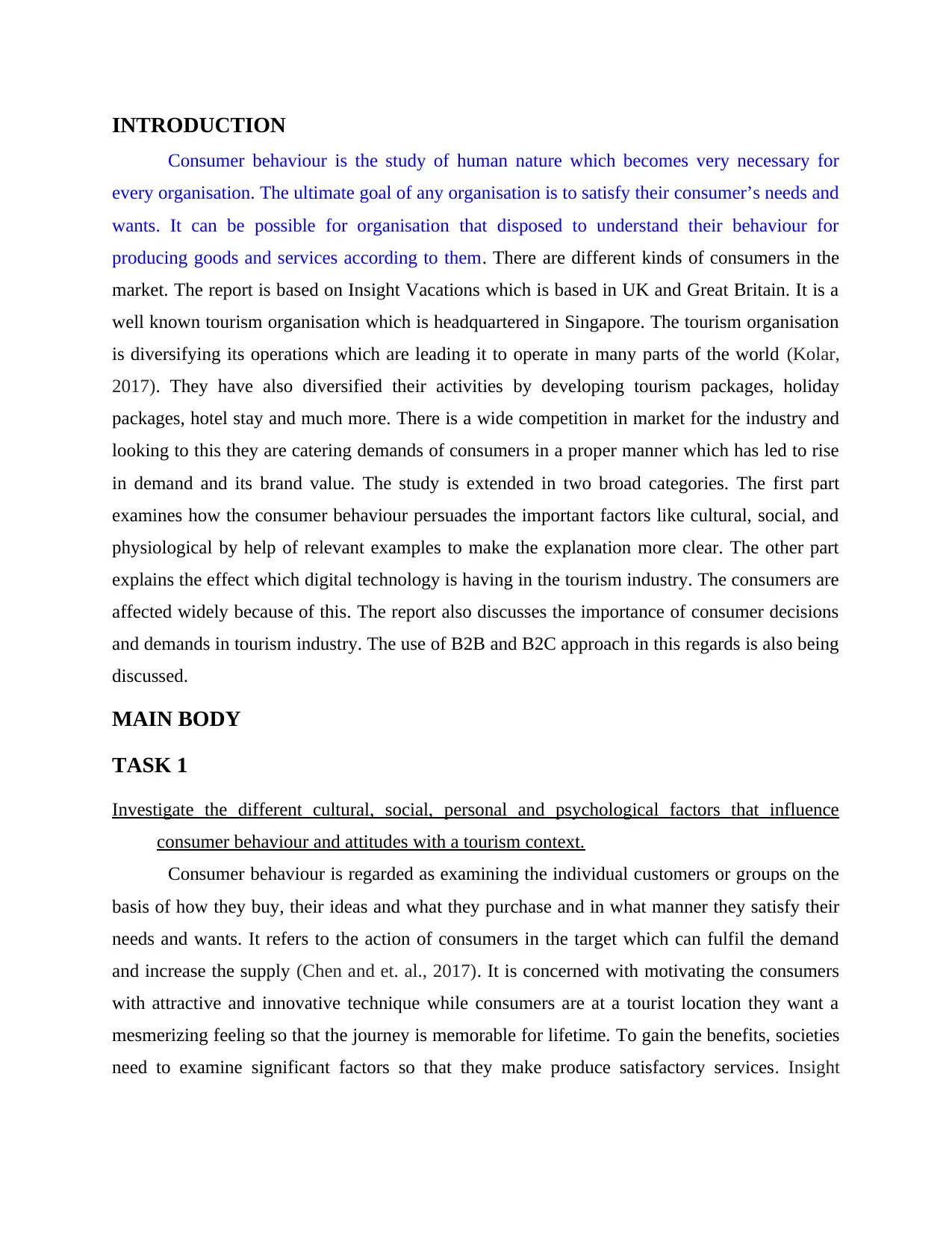
INTRODUCTION
Consumer behaviour is the study of human nature which becomes very necessary for
every organisation. The ultimate goal of any organisation is to satisfy their consumer’s needs and
wants. It can be possible for organisation that disposed to understand their behaviour for
producing goods and services according to them. There are different kinds of consumers in the
market. The report is based on Insight Vacations which is based in UK and Great Britain. It is a
well known tourism organisation which is headquartered in Singapore. The tourism organisation
is diversifying its operations which are leading it to operate in many parts of the world (Kolar,
2017). They have also diversified their activities by developing tourism packages, holiday
packages, hotel stay and much more. There is a wide competition in market for the industry and
looking to this they are catering demands of consumers in a proper manner which has led to rise
in demand and its brand value. The study is extended in two broad categories. The first part
examines how the consumer behaviour persuades the important factors like cultural, social, and
physiological by help of relevant examples to make the explanation more clear. The other part
explains the effect which digital technology is having in the tourism industry. The consumers are
affected widely because of this. The report also discusses the importance of consumer decisions
and demands in tourism industry. The use of B2B and B2C approach in this regards is also being
discussed.
MAIN BODY
TASK 1
Investigate the different cultural, social, personal and psychological factors that influence
consumer behaviour and attitudes with a tourism context.
Consumer behaviour is regarded as examining the individual customers or groups on the
basis of how they buy, their ideas and what they purchase and in what manner they satisfy their
needs and wants. It refers to the action of consumers in the target which can fulfil the demand
and increase the supply (Chen and et. al., 2017). It is concerned with motivating the consumers
with attractive and innovative technique while consumers are at a tourist location they want a
mesmerizing feeling so that the journey is memorable for lifetime. To gain the benefits, societies
need to examine significant factors so that they make produce satisfactory services. Insight
Consumer behaviour is the study of human nature which becomes very necessary for
every organisation. The ultimate goal of any organisation is to satisfy their consumer’s needs and
wants. It can be possible for organisation that disposed to understand their behaviour for
producing goods and services according to them. There are different kinds of consumers in the
market. The report is based on Insight Vacations which is based in UK and Great Britain. It is a
well known tourism organisation which is headquartered in Singapore. The tourism organisation
is diversifying its operations which are leading it to operate in many parts of the world (Kolar,
2017). They have also diversified their activities by developing tourism packages, holiday
packages, hotel stay and much more. There is a wide competition in market for the industry and
looking to this they are catering demands of consumers in a proper manner which has led to rise
in demand and its brand value. The study is extended in two broad categories. The first part
examines how the consumer behaviour persuades the important factors like cultural, social, and
physiological by help of relevant examples to make the explanation more clear. The other part
explains the effect which digital technology is having in the tourism industry. The consumers are
affected widely because of this. The report also discusses the importance of consumer decisions
and demands in tourism industry. The use of B2B and B2C approach in this regards is also being
discussed.
MAIN BODY
TASK 1
Investigate the different cultural, social, personal and psychological factors that influence
consumer behaviour and attitudes with a tourism context.
Consumer behaviour is regarded as examining the individual customers or groups on the
basis of how they buy, their ideas and what they purchase and in what manner they satisfy their
needs and wants. It refers to the action of consumers in the target which can fulfil the demand
and increase the supply (Chen and et. al., 2017). It is concerned with motivating the consumers
with attractive and innovative technique while consumers are at a tourist location they want a
mesmerizing feeling so that the journey is memorable for lifetime. To gain the benefits, societies
need to examine significant factors so that they make produce satisfactory services. Insight
⊘ This is a preview!⊘
Do you want full access?
Subscribe today to unlock all pages.

Trusted by 1+ million students worldwide
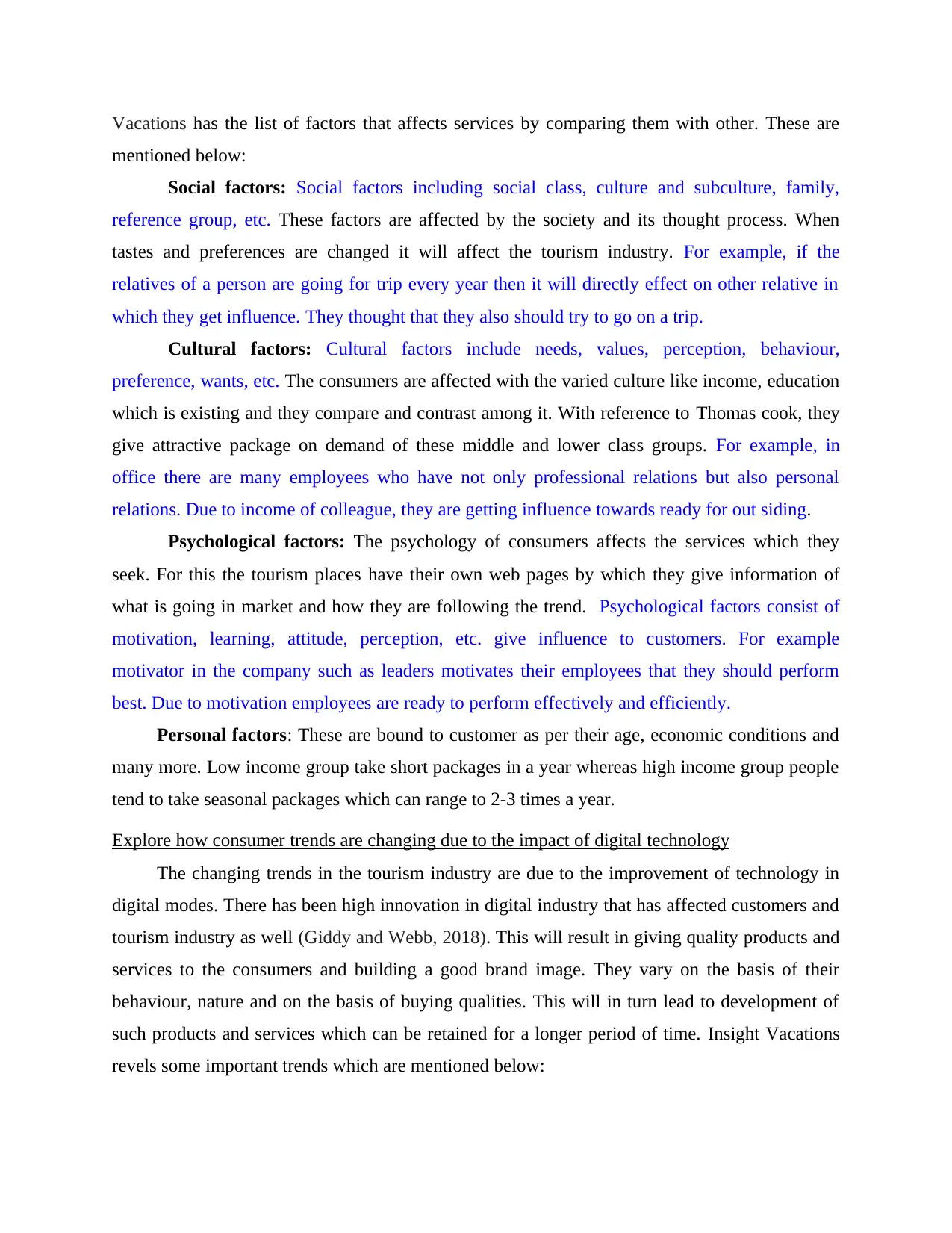
Vacations has the list of factors that affects services by comparing them with other. These are
mentioned below:
Social factors: Social factors including social class, culture and subculture, family,
reference group, etc. These factors are affected by the society and its thought process. When
tastes and preferences are changed it will affect the tourism industry. For example, if the
relatives of a person are going for trip every year then it will directly effect on other relative in
which they get influence. They thought that they also should try to go on a trip.
Cultural factors: Cultural factors include needs, values, perception, behaviour,
preference, wants, etc. The consumers are affected with the varied culture like income, education
which is existing and they compare and contrast among it. With reference to Thomas cook, they
give attractive package on demand of these middle and lower class groups. For example, in
office there are many employees who have not only professional relations but also personal
relations. Due to income of colleague, they are getting influence towards ready for out siding.
Psychological factors: The psychology of consumers affects the services which they
seek. For this the tourism places have their own web pages by which they give information of
what is going in market and how they are following the trend. Psychological factors consist of
motivation, learning, attitude, perception, etc. give influence to customers. For example
motivator in the company such as leaders motivates their employees that they should perform
best. Due to motivation employees are ready to perform effectively and efficiently.
Personal factors: These are bound to customer as per their age, economic conditions and
many more. Low income group take short packages in a year whereas high income group people
tend to take seasonal packages which can range to 2-3 times a year.
Explore how consumer trends are changing due to the impact of digital technology
The changing trends in the tourism industry are due to the improvement of technology in
digital modes. There has been high innovation in digital industry that has affected customers and
tourism industry as well (Giddy and Webb, 2018). This will result in giving quality products and
services to the consumers and building a good brand image. They vary on the basis of their
behaviour, nature and on the basis of buying qualities. This will in turn lead to development of
such products and services which can be retained for a longer period of time. Insight Vacations
revels some important trends which are mentioned below:
mentioned below:
Social factors: Social factors including social class, culture and subculture, family,
reference group, etc. These factors are affected by the society and its thought process. When
tastes and preferences are changed it will affect the tourism industry. For example, if the
relatives of a person are going for trip every year then it will directly effect on other relative in
which they get influence. They thought that they also should try to go on a trip.
Cultural factors: Cultural factors include needs, values, perception, behaviour,
preference, wants, etc. The consumers are affected with the varied culture like income, education
which is existing and they compare and contrast among it. With reference to Thomas cook, they
give attractive package on demand of these middle and lower class groups. For example, in
office there are many employees who have not only professional relations but also personal
relations. Due to income of colleague, they are getting influence towards ready for out siding.
Psychological factors: The psychology of consumers affects the services which they
seek. For this the tourism places have their own web pages by which they give information of
what is going in market and how they are following the trend. Psychological factors consist of
motivation, learning, attitude, perception, etc. give influence to customers. For example
motivator in the company such as leaders motivates their employees that they should perform
best. Due to motivation employees are ready to perform effectively and efficiently.
Personal factors: These are bound to customer as per their age, economic conditions and
many more. Low income group take short packages in a year whereas high income group people
tend to take seasonal packages which can range to 2-3 times a year.
Explore how consumer trends are changing due to the impact of digital technology
The changing trends in the tourism industry are due to the improvement of technology in
digital modes. There has been high innovation in digital industry that has affected customers and
tourism industry as well (Giddy and Webb, 2018). This will result in giving quality products and
services to the consumers and building a good brand image. They vary on the basis of their
behaviour, nature and on the basis of buying qualities. This will in turn lead to development of
such products and services which can be retained for a longer period of time. Insight Vacations
revels some important trends which are mentioned below:
Paraphrase This Document
Need a fresh take? Get an instant paraphrase of this document with our AI Paraphraser
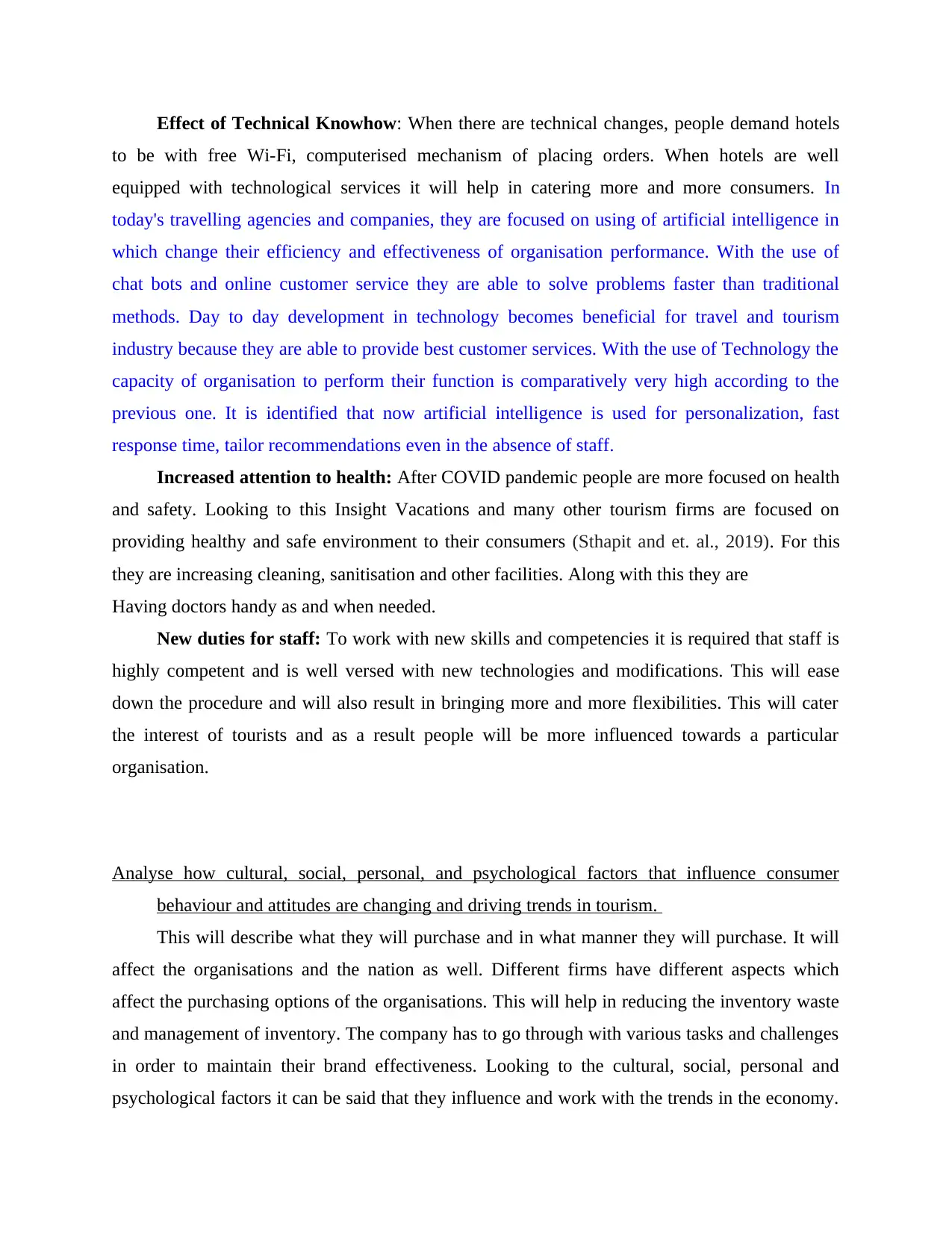
Effect of Technical Knowhow: When there are technical changes, people demand hotels
to be with free Wi-Fi, computerised mechanism of placing orders. When hotels are well
equipped with technological services it will help in catering more and more consumers. In
today's travelling agencies and companies, they are focused on using of artificial intelligence in
which change their efficiency and effectiveness of organisation performance. With the use of
chat bots and online customer service they are able to solve problems faster than traditional
methods. Day to day development in technology becomes beneficial for travel and tourism
industry because they are able to provide best customer services. With the use of Technology the
capacity of organisation to perform their function is comparatively very high according to the
previous one. It is identified that now artificial intelligence is used for personalization, fast
response time, tailor recommendations even in the absence of staff.
Increased attention to health: After COVID pandemic people are more focused on health
and safety. Looking to this Insight Vacations and many other tourism firms are focused on
providing healthy and safe environment to their consumers (Sthapit and et. al., 2019). For this
they are increasing cleaning, sanitisation and other facilities. Along with this they are
Having doctors handy as and when needed.
New duties for staff: To work with new skills and competencies it is required that staff is
highly competent and is well versed with new technologies and modifications. This will ease
down the procedure and will also result in bringing more and more flexibilities. This will cater
the interest of tourists and as a result people will be more influenced towards a particular
organisation.
Analyse how cultural, social, personal, and psychological factors that influence consumer
behaviour and attitudes are changing and driving trends in tourism.
This will describe what they will purchase and in what manner they will purchase. It will
affect the organisations and the nation as well. Different firms have different aspects which
affect the purchasing options of the organisations. This will help in reducing the inventory waste
and management of inventory. The company has to go through with various tasks and challenges
in order to maintain their brand effectiveness. Looking to the cultural, social, personal and
psychological factors it can be said that they influence and work with the trends in the economy.
to be with free Wi-Fi, computerised mechanism of placing orders. When hotels are well
equipped with technological services it will help in catering more and more consumers. In
today's travelling agencies and companies, they are focused on using of artificial intelligence in
which change their efficiency and effectiveness of organisation performance. With the use of
chat bots and online customer service they are able to solve problems faster than traditional
methods. Day to day development in technology becomes beneficial for travel and tourism
industry because they are able to provide best customer services. With the use of Technology the
capacity of organisation to perform their function is comparatively very high according to the
previous one. It is identified that now artificial intelligence is used for personalization, fast
response time, tailor recommendations even in the absence of staff.
Increased attention to health: After COVID pandemic people are more focused on health
and safety. Looking to this Insight Vacations and many other tourism firms are focused on
providing healthy and safe environment to their consumers (Sthapit and et. al., 2019). For this
they are increasing cleaning, sanitisation and other facilities. Along with this they are
Having doctors handy as and when needed.
New duties for staff: To work with new skills and competencies it is required that staff is
highly competent and is well versed with new technologies and modifications. This will ease
down the procedure and will also result in bringing more and more flexibilities. This will cater
the interest of tourists and as a result people will be more influenced towards a particular
organisation.
Analyse how cultural, social, personal, and psychological factors that influence consumer
behaviour and attitudes are changing and driving trends in tourism.
This will describe what they will purchase and in what manner they will purchase. It will
affect the organisations and the nation as well. Different firms have different aspects which
affect the purchasing options of the organisations. This will help in reducing the inventory waste
and management of inventory. The company has to go through with various tasks and challenges
in order to maintain their brand effectiveness. Looking to the cultural, social, personal and
psychological factors it can be said that they influence and work with the trends in the economy.
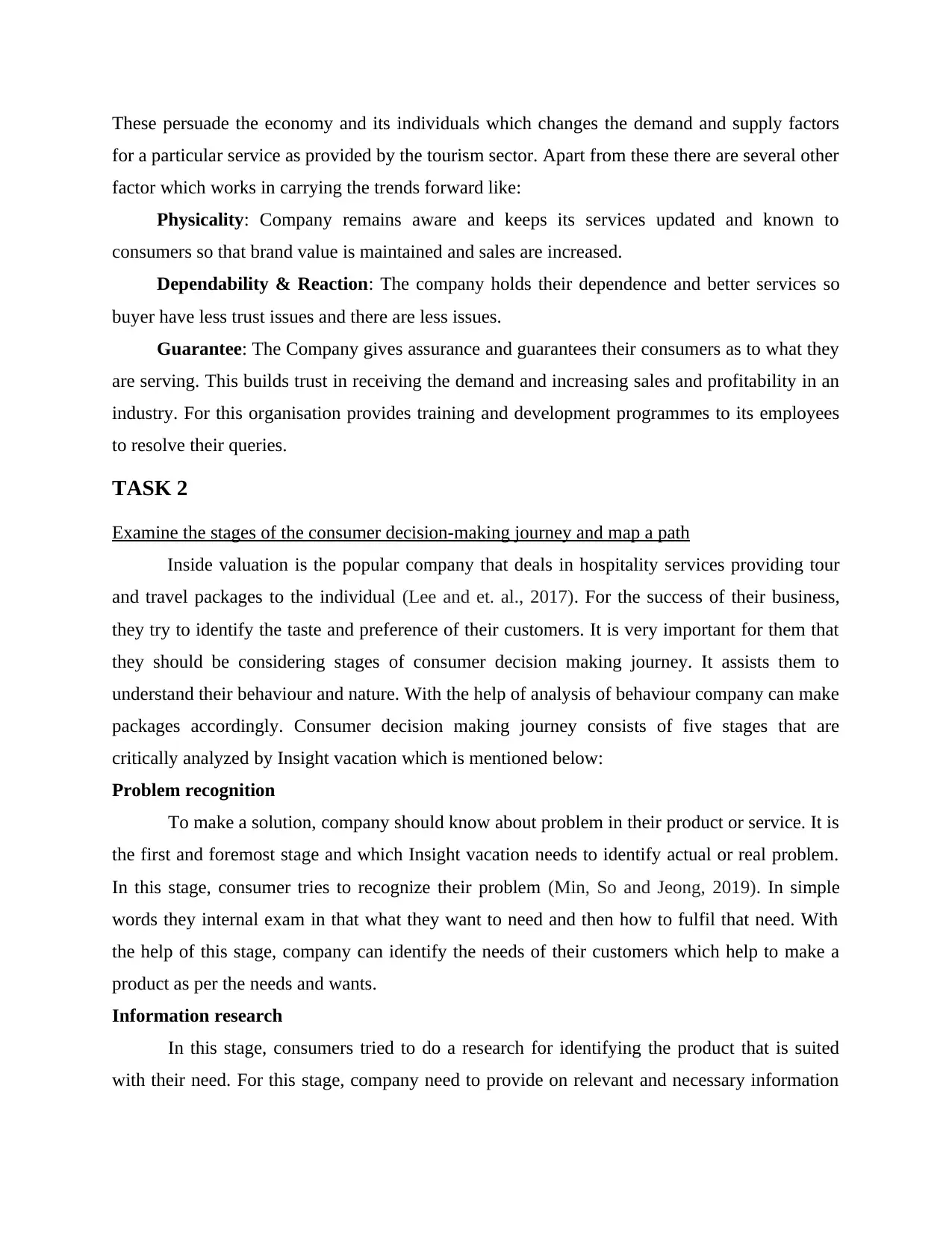
These persuade the economy and its individuals which changes the demand and supply factors
for a particular service as provided by the tourism sector. Apart from these there are several other
factor which works in carrying the trends forward like:
Physicality: Company remains aware and keeps its services updated and known to
consumers so that brand value is maintained and sales are increased.
Dependability & Reaction: The company holds their dependence and better services so
buyer have less trust issues and there are less issues.
Guarantee: The Company gives assurance and guarantees their consumers as to what they
are serving. This builds trust in receiving the demand and increasing sales and profitability in an
industry. For this organisation provides training and development programmes to its employees
to resolve their queries.
TASK 2
Examine the stages of the consumer decision-making journey and map a path
Inside valuation is the popular company that deals in hospitality services providing tour
and travel packages to the individual (Lee and et. al., 2017). For the success of their business,
they try to identify the taste and preference of their customers. It is very important for them that
they should be considering stages of consumer decision making journey. It assists them to
understand their behaviour and nature. With the help of analysis of behaviour company can make
packages accordingly. Consumer decision making journey consists of five stages that are
critically analyzed by Insight vacation which is mentioned below:
Problem recognition
To make a solution, company should know about problem in their product or service. It is
the first and foremost stage and which Insight vacation needs to identify actual or real problem.
In this stage, consumer tries to recognize their problem (Min, So and Jeong, 2019). In simple
words they internal exam in that what they want to need and then how to fulfil that need. With
the help of this stage, company can identify the needs of their customers which help to make a
product as per the needs and wants.
Information research
In this stage, consumers tried to do a research for identifying the product that is suited
with their need. For this stage, company need to provide on relevant and necessary information
for a particular service as provided by the tourism sector. Apart from these there are several other
factor which works in carrying the trends forward like:
Physicality: Company remains aware and keeps its services updated and known to
consumers so that brand value is maintained and sales are increased.
Dependability & Reaction: The company holds their dependence and better services so
buyer have less trust issues and there are less issues.
Guarantee: The Company gives assurance and guarantees their consumers as to what they
are serving. This builds trust in receiving the demand and increasing sales and profitability in an
industry. For this organisation provides training and development programmes to its employees
to resolve their queries.
TASK 2
Examine the stages of the consumer decision-making journey and map a path
Inside valuation is the popular company that deals in hospitality services providing tour
and travel packages to the individual (Lee and et. al., 2017). For the success of their business,
they try to identify the taste and preference of their customers. It is very important for them that
they should be considering stages of consumer decision making journey. It assists them to
understand their behaviour and nature. With the help of analysis of behaviour company can make
packages accordingly. Consumer decision making journey consists of five stages that are
critically analyzed by Insight vacation which is mentioned below:
Problem recognition
To make a solution, company should know about problem in their product or service. It is
the first and foremost stage and which Insight vacation needs to identify actual or real problem.
In this stage, consumer tries to recognize their problem (Min, So and Jeong, 2019). In simple
words they internal exam in that what they want to need and then how to fulfil that need. With
the help of this stage, company can identify the needs of their customers which help to make a
product as per the needs and wants.
Information research
In this stage, consumers tried to do a research for identifying the product that is suited
with their need. For this stage, company need to provide on relevant and necessary information
⊘ This is a preview!⊘
Do you want full access?
Subscribe today to unlock all pages.

Trusted by 1+ million students worldwide
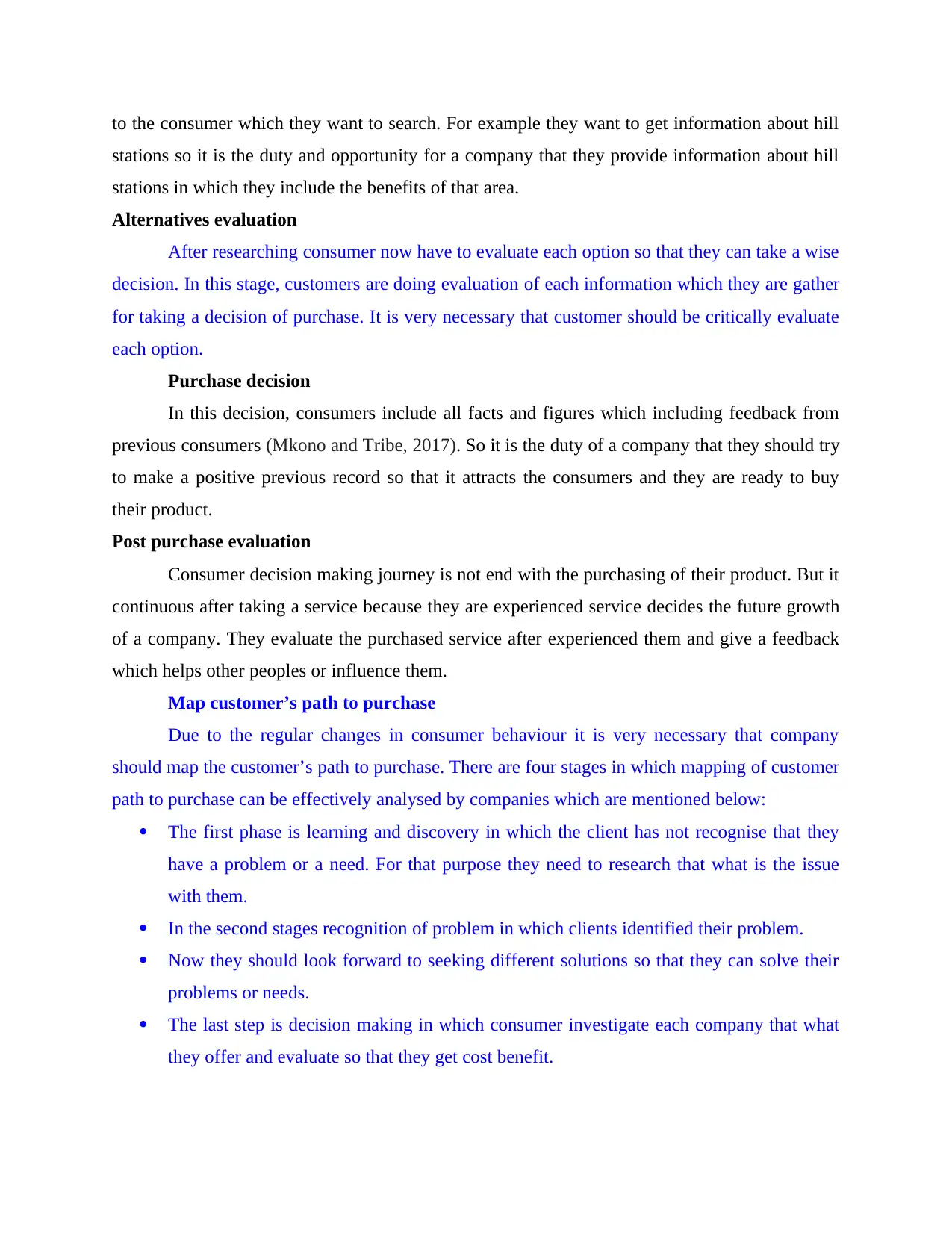
to the consumer which they want to search. For example they want to get information about hill
stations so it is the duty and opportunity for a company that they provide information about hill
stations in which they include the benefits of that area.
Alternatives evaluation
After researching consumer now have to evaluate each option so that they can take a wise
decision. In this stage, customers are doing evaluation of each information which they are gather
for taking a decision of purchase. It is very necessary that customer should be critically evaluate
each option.
Purchase decision
In this decision, consumers include all facts and figures which including feedback from
previous consumers (Mkono and Tribe, 2017). So it is the duty of a company that they should try
to make a positive previous record so that it attracts the consumers and they are ready to buy
their product.
Post purchase evaluation
Consumer decision making journey is not end with the purchasing of their product. But it
continuous after taking a service because they are experienced service decides the future growth
of a company. They evaluate the purchased service after experienced them and give a feedback
which helps other peoples or influence them.
Map customer’s path to purchase
Due to the regular changes in consumer behaviour it is very necessary that company
should map the customer’s path to purchase. There are four stages in which mapping of customer
path to purchase can be effectively analysed by companies which are mentioned below:
The first phase is learning and discovery in which the client has not recognise that they
have a problem or a need. For that purpose they need to research that what is the issue
with them.
In the second stages recognition of problem in which clients identified their problem.
Now they should look forward to seeking different solutions so that they can solve their
problems or needs.
The last step is decision making in which consumer investigate each company that what
they offer and evaluate so that they get cost benefit.
stations so it is the duty and opportunity for a company that they provide information about hill
stations in which they include the benefits of that area.
Alternatives evaluation
After researching consumer now have to evaluate each option so that they can take a wise
decision. In this stage, customers are doing evaluation of each information which they are gather
for taking a decision of purchase. It is very necessary that customer should be critically evaluate
each option.
Purchase decision
In this decision, consumers include all facts and figures which including feedback from
previous consumers (Mkono and Tribe, 2017). So it is the duty of a company that they should try
to make a positive previous record so that it attracts the consumers and they are ready to buy
their product.
Post purchase evaluation
Consumer decision making journey is not end with the purchasing of their product. But it
continuous after taking a service because they are experienced service decides the future growth
of a company. They evaluate the purchased service after experienced them and give a feedback
which helps other peoples or influence them.
Map customer’s path to purchase
Due to the regular changes in consumer behaviour it is very necessary that company
should map the customer’s path to purchase. There are four stages in which mapping of customer
path to purchase can be effectively analysed by companies which are mentioned below:
The first phase is learning and discovery in which the client has not recognise that they
have a problem or a need. For that purpose they need to research that what is the issue
with them.
In the second stages recognition of problem in which clients identified their problem.
Now they should look forward to seeking different solutions so that they can solve their
problems or needs.
The last step is decision making in which consumer investigate each company that what
they offer and evaluate so that they get cost benefit.
Paraphrase This Document
Need a fresh take? Get an instant paraphrase of this document with our AI Paraphraser
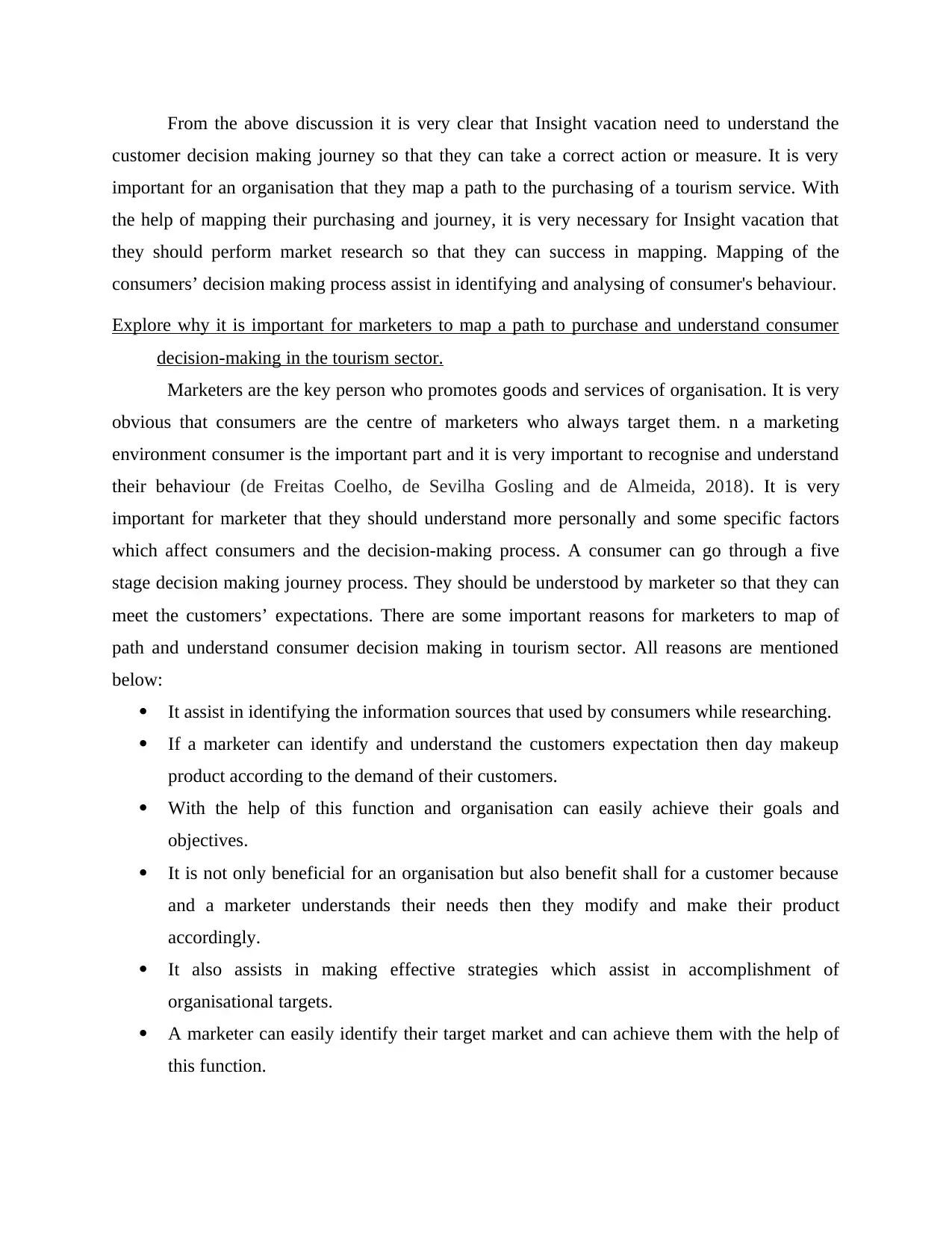
From the above discussion it is very clear that Insight vacation need to understand the
customer decision making journey so that they can take a correct action or measure. It is very
important for an organisation that they map a path to the purchasing of a tourism service. With
the help of mapping their purchasing and journey, it is very necessary for Insight vacation that
they should perform market research so that they can success in mapping. Mapping of the
consumers’ decision making process assist in identifying and analysing of consumer's behaviour.
Explore why it is important for marketers to map a path to purchase and understand consumer
decision-making in the tourism sector.
Marketers are the key person who promotes goods and services of organisation. It is very
obvious that consumers are the centre of marketers who always target them. n a marketing
environment consumer is the important part and it is very important to recognise and understand
their behaviour (de Freitas Coelho, de Sevilha Gosling and de Almeida, 2018). It is very
important for marketer that they should understand more personally and some specific factors
which affect consumers and the decision-making process. A consumer can go through a five
stage decision making journey process. They should be understood by marketer so that they can
meet the customers’ expectations. There are some important reasons for marketers to map of
path and understand consumer decision making in tourism sector. All reasons are mentioned
below:
It assist in identifying the information sources that used by consumers while researching.
If a marketer can identify and understand the customers expectation then day makeup
product according to the demand of their customers.
With the help of this function and organisation can easily achieve their goals and
objectives.
It is not only beneficial for an organisation but also benefit shall for a customer because
and a marketer understands their needs then they modify and make their product
accordingly.
It also assists in making effective strategies which assist in accomplishment of
organisational targets.
A marketer can easily identify their target market and can achieve them with the help of
this function.
customer decision making journey so that they can take a correct action or measure. It is very
important for an organisation that they map a path to the purchasing of a tourism service. With
the help of mapping their purchasing and journey, it is very necessary for Insight vacation that
they should perform market research so that they can success in mapping. Mapping of the
consumers’ decision making process assist in identifying and analysing of consumer's behaviour.
Explore why it is important for marketers to map a path to purchase and understand consumer
decision-making in the tourism sector.
Marketers are the key person who promotes goods and services of organisation. It is very
obvious that consumers are the centre of marketers who always target them. n a marketing
environment consumer is the important part and it is very important to recognise and understand
their behaviour (de Freitas Coelho, de Sevilha Gosling and de Almeida, 2018). It is very
important for marketer that they should understand more personally and some specific factors
which affect consumers and the decision-making process. A consumer can go through a five
stage decision making journey process. They should be understood by marketer so that they can
meet the customers’ expectations. There are some important reasons for marketers to map of
path and understand consumer decision making in tourism sector. All reasons are mentioned
below:
It assist in identifying the information sources that used by consumers while researching.
If a marketer can identify and understand the customers expectation then day makeup
product according to the demand of their customers.
With the help of this function and organisation can easily achieve their goals and
objectives.
It is not only beneficial for an organisation but also benefit shall for a customer because
and a marketer understands their needs then they modify and make their product
accordingly.
It also assists in making effective strategies which assist in accomplishment of
organisational targets.
A marketer can easily identify their target market and can achieve them with the help of
this function.
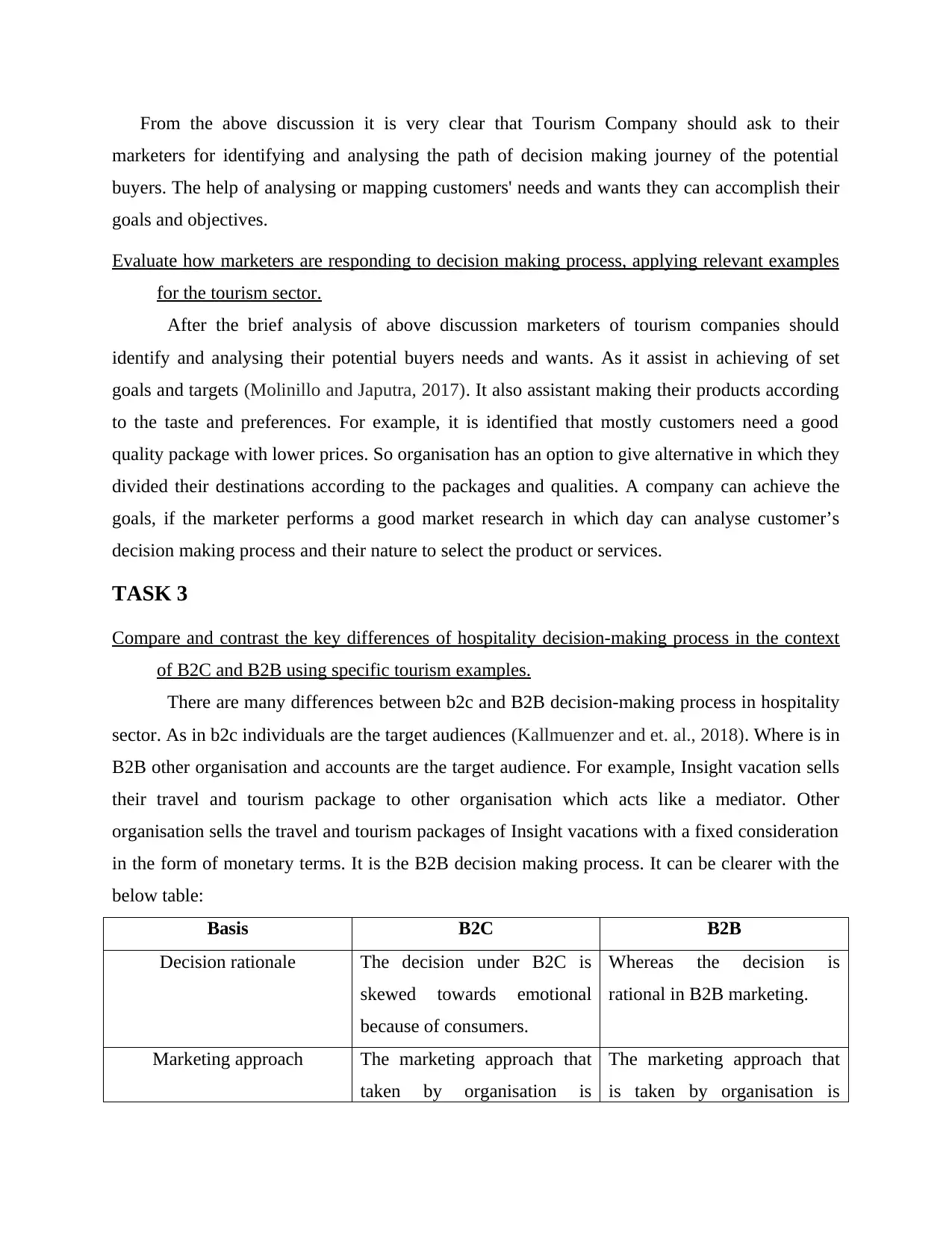
From the above discussion it is very clear that Tourism Company should ask to their
marketers for identifying and analysing the path of decision making journey of the potential
buyers. The help of analysing or mapping customers' needs and wants they can accomplish their
goals and objectives.
Evaluate how marketers are responding to decision making process, applying relevant examples
for the tourism sector.
After the brief analysis of above discussion marketers of tourism companies should
identify and analysing their potential buyers needs and wants. As it assist in achieving of set
goals and targets (Molinillo and Japutra, 2017). It also assistant making their products according
to the taste and preferences. For example, it is identified that mostly customers need a good
quality package with lower prices. So organisation has an option to give alternative in which they
divided their destinations according to the packages and qualities. A company can achieve the
goals, if the marketer performs a good market research in which day can analyse customer’s
decision making process and their nature to select the product or services.
TASK 3
Compare and contrast the key differences of hospitality decision-making process in the context
of B2C and B2B using specific tourism examples.
There are many differences between b2c and B2B decision-making process in hospitality
sector. As in b2c individuals are the target audiences (Kallmuenzer and et. al., 2018). Where is in
B2B other organisation and accounts are the target audience. For example, Insight vacation sells
their travel and tourism package to other organisation which acts like a mediator. Other
organisation sells the travel and tourism packages of Insight vacations with a fixed consideration
in the form of monetary terms. It is the B2B decision making process. It can be clearer with the
below table:
Basis B2C B2B
Decision rationale The decision under B2C is
skewed towards emotional
because of consumers.
Whereas the decision is
rational in B2B marketing.
Marketing approach The marketing approach that
taken by organisation is
The marketing approach that
is taken by organisation is
marketers for identifying and analysing the path of decision making journey of the potential
buyers. The help of analysing or mapping customers' needs and wants they can accomplish their
goals and objectives.
Evaluate how marketers are responding to decision making process, applying relevant examples
for the tourism sector.
After the brief analysis of above discussion marketers of tourism companies should
identify and analysing their potential buyers needs and wants. As it assist in achieving of set
goals and targets (Molinillo and Japutra, 2017). It also assistant making their products according
to the taste and preferences. For example, it is identified that mostly customers need a good
quality package with lower prices. So organisation has an option to give alternative in which they
divided their destinations according to the packages and qualities. A company can achieve the
goals, if the marketer performs a good market research in which day can analyse customer’s
decision making process and their nature to select the product or services.
TASK 3
Compare and contrast the key differences of hospitality decision-making process in the context
of B2C and B2B using specific tourism examples.
There are many differences between b2c and B2B decision-making process in hospitality
sector. As in b2c individuals are the target audiences (Kallmuenzer and et. al., 2018). Where is in
B2B other organisation and accounts are the target audience. For example, Insight vacation sells
their travel and tourism package to other organisation which acts like a mediator. Other
organisation sells the travel and tourism packages of Insight vacations with a fixed consideration
in the form of monetary terms. It is the B2B decision making process. It can be clearer with the
below table:
Basis B2C B2B
Decision rationale The decision under B2C is
skewed towards emotional
because of consumers.
Whereas the decision is
rational in B2B marketing.
Marketing approach The marketing approach that
taken by organisation is
The marketing approach that
is taken by organisation is
⊘ This is a preview!⊘
Do you want full access?
Subscribe today to unlock all pages.

Trusted by 1+ million students worldwide
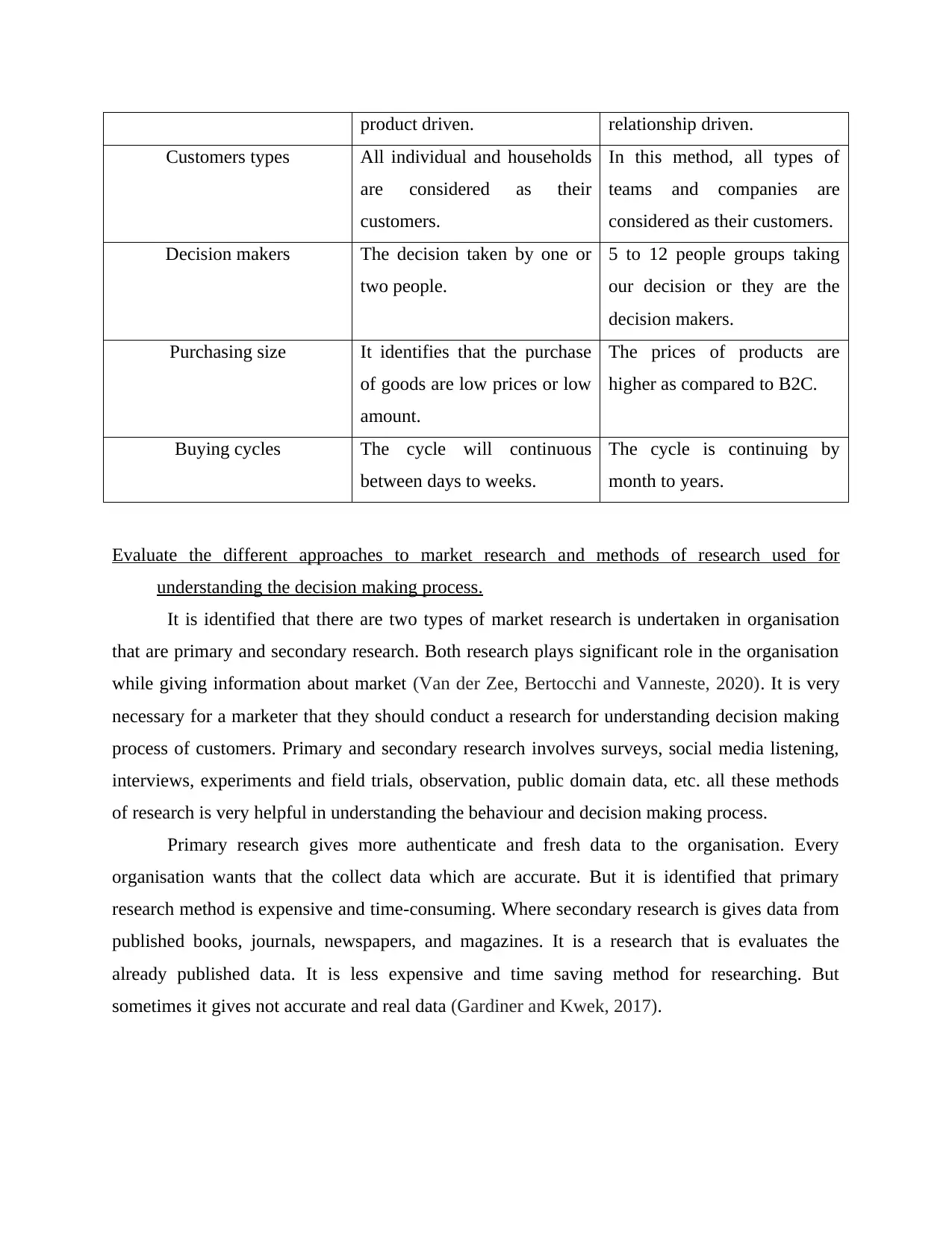
product driven. relationship driven.
Customers types All individual and households
are considered as their
customers.
In this method, all types of
teams and companies are
considered as their customers.
Decision makers The decision taken by one or
two people.
5 to 12 people groups taking
our decision or they are the
decision makers.
Purchasing size It identifies that the purchase
of goods are low prices or low
amount.
The prices of products are
higher as compared to B2C.
Buying cycles The cycle will continuous
between days to weeks.
The cycle is continuing by
month to years.
Evaluate the different approaches to market research and methods of research used for
understanding the decision making process.
It is identified that there are two types of market research is undertaken in organisation
that are primary and secondary research. Both research plays significant role in the organisation
while giving information about market (Van der Zee, Bertocchi and Vanneste, 2020). It is very
necessary for a marketer that they should conduct a research for understanding decision making
process of customers. Primary and secondary research involves surveys, social media listening,
interviews, experiments and field trials, observation, public domain data, etc. all these methods
of research is very helpful in understanding the behaviour and decision making process.
Primary research gives more authenticate and fresh data to the organisation. Every
organisation wants that the collect data which are accurate. But it is identified that primary
research method is expensive and time-consuming. Where secondary research is gives data from
published books, journals, newspapers, and magazines. It is a research that is evaluates the
already published data. It is less expensive and time saving method for researching. But
sometimes it gives not accurate and real data (Gardiner and Kwek, 2017).
Customers types All individual and households
are considered as their
customers.
In this method, all types of
teams and companies are
considered as their customers.
Decision makers The decision taken by one or
two people.
5 to 12 people groups taking
our decision or they are the
decision makers.
Purchasing size It identifies that the purchase
of goods are low prices or low
amount.
The prices of products are
higher as compared to B2C.
Buying cycles The cycle will continuous
between days to weeks.
The cycle is continuing by
month to years.
Evaluate the different approaches to market research and methods of research used for
understanding the decision making process.
It is identified that there are two types of market research is undertaken in organisation
that are primary and secondary research. Both research plays significant role in the organisation
while giving information about market (Van der Zee, Bertocchi and Vanneste, 2020). It is very
necessary for a marketer that they should conduct a research for understanding decision making
process of customers. Primary and secondary research involves surveys, social media listening,
interviews, experiments and field trials, observation, public domain data, etc. all these methods
of research is very helpful in understanding the behaviour and decision making process.
Primary research gives more authenticate and fresh data to the organisation. Every
organisation wants that the collect data which are accurate. But it is identified that primary
research method is expensive and time-consuming. Where secondary research is gives data from
published books, journals, newspapers, and magazines. It is a research that is evaluates the
already published data. It is less expensive and time saving method for researching. But
sometimes it gives not accurate and real data (Gardiner and Kwek, 2017).
Paraphrase This Document
Need a fresh take? Get an instant paraphrase of this document with our AI Paraphraser
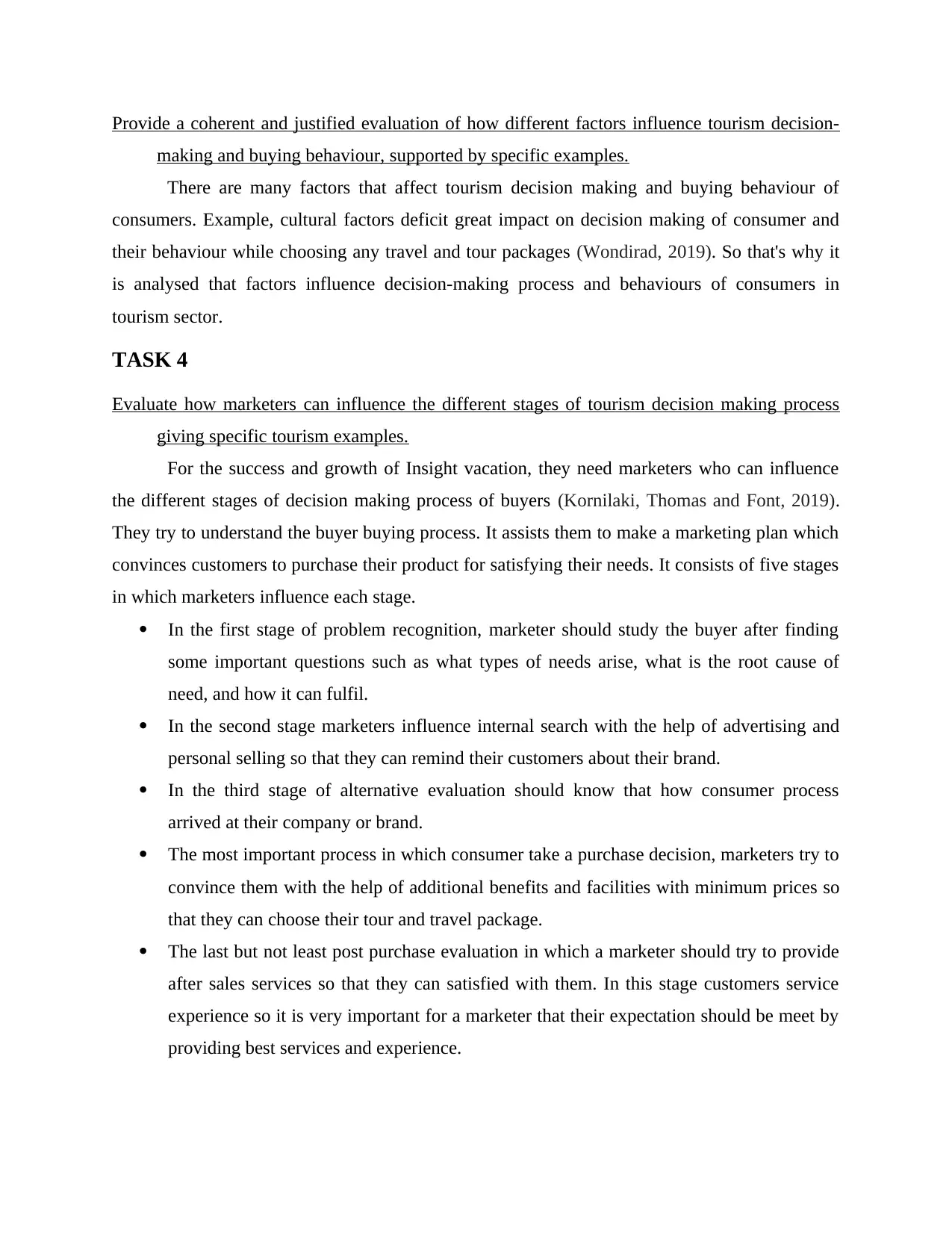
Provide a coherent and justified evaluation of how different factors influence tourism decision-
making and buying behaviour, supported by specific examples.
There are many factors that affect tourism decision making and buying behaviour of
consumers. Example, cultural factors deficit great impact on decision making of consumer and
their behaviour while choosing any travel and tour packages (Wondirad, 2019). So that's why it
is analysed that factors influence decision-making process and behaviours of consumers in
tourism sector.
TASK 4
Evaluate how marketers can influence the different stages of tourism decision making process
giving specific tourism examples.
For the success and growth of Insight vacation, they need marketers who can influence
the different stages of decision making process of buyers (Kornilaki, Thomas and Font, 2019).
They try to understand the buyer buying process. It assists them to make a marketing plan which
convinces customers to purchase their product for satisfying their needs. It consists of five stages
in which marketers influence each stage.
In the first stage of problem recognition, marketer should study the buyer after finding
some important questions such as what types of needs arise, what is the root cause of
need, and how it can fulfil.
In the second stage marketers influence internal search with the help of advertising and
personal selling so that they can remind their customers about their brand.
In the third stage of alternative evaluation should know that how consumer process
arrived at their company or brand.
The most important process in which consumer take a purchase decision, marketers try to
convince them with the help of additional benefits and facilities with minimum prices so
that they can choose their tour and travel package.
The last but not least post purchase evaluation in which a marketer should try to provide
after sales services so that they can satisfied with them. In this stage customers service
experience so it is very important for a marketer that their expectation should be meet by
providing best services and experience.
making and buying behaviour, supported by specific examples.
There are many factors that affect tourism decision making and buying behaviour of
consumers. Example, cultural factors deficit great impact on decision making of consumer and
their behaviour while choosing any travel and tour packages (Wondirad, 2019). So that's why it
is analysed that factors influence decision-making process and behaviours of consumers in
tourism sector.
TASK 4
Evaluate how marketers can influence the different stages of tourism decision making process
giving specific tourism examples.
For the success and growth of Insight vacation, they need marketers who can influence
the different stages of decision making process of buyers (Kornilaki, Thomas and Font, 2019).
They try to understand the buyer buying process. It assists them to make a marketing plan which
convinces customers to purchase their product for satisfying their needs. It consists of five stages
in which marketers influence each stage.
In the first stage of problem recognition, marketer should study the buyer after finding
some important questions such as what types of needs arise, what is the root cause of
need, and how it can fulfil.
In the second stage marketers influence internal search with the help of advertising and
personal selling so that they can remind their customers about their brand.
In the third stage of alternative evaluation should know that how consumer process
arrived at their company or brand.
The most important process in which consumer take a purchase decision, marketers try to
convince them with the help of additional benefits and facilities with minimum prices so
that they can choose their tour and travel package.
The last but not least post purchase evaluation in which a marketer should try to provide
after sales services so that they can satisfied with them. In this stage customers service
experience so it is very important for a marketer that their expectation should be meet by
providing best services and experience.
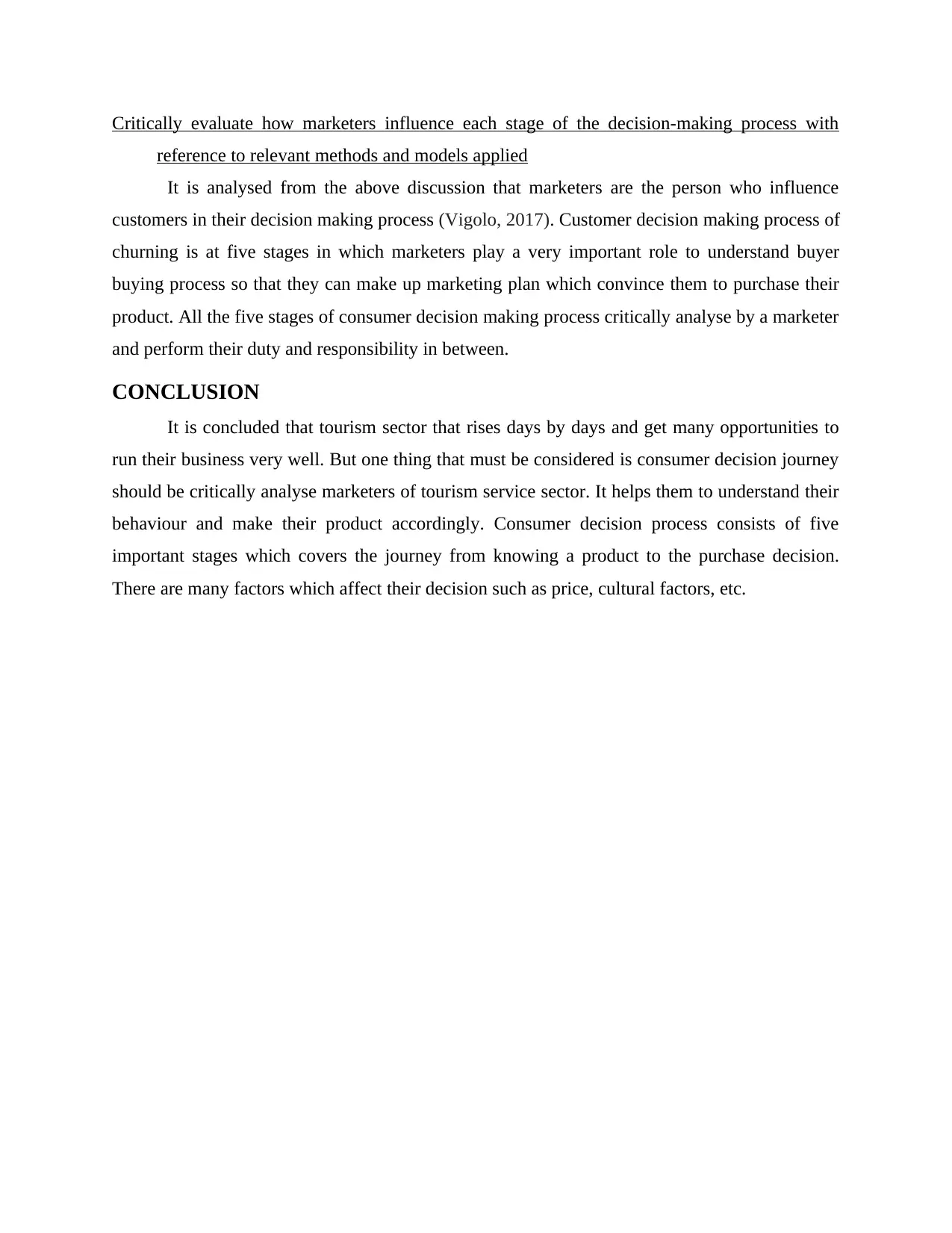
Critically evaluate how marketers influence each stage of the decision-making process with
reference to relevant methods and models applied
It is analysed from the above discussion that marketers are the person who influence
customers in their decision making process (Vigolo, 2017). Customer decision making process of
churning is at five stages in which marketers play a very important role to understand buyer
buying process so that they can make up marketing plan which convince them to purchase their
product. All the five stages of consumer decision making process critically analyse by a marketer
and perform their duty and responsibility in between.
CONCLUSION
It is concluded that tourism sector that rises days by days and get many opportunities to
run their business very well. But one thing that must be considered is consumer decision journey
should be critically analyse marketers of tourism service sector. It helps them to understand their
behaviour and make their product accordingly. Consumer decision process consists of five
important stages which covers the journey from knowing a product to the purchase decision.
There are many factors which affect their decision such as price, cultural factors, etc.
reference to relevant methods and models applied
It is analysed from the above discussion that marketers are the person who influence
customers in their decision making process (Vigolo, 2017). Customer decision making process of
churning is at five stages in which marketers play a very important role to understand buyer
buying process so that they can make up marketing plan which convince them to purchase their
product. All the five stages of consumer decision making process critically analyse by a marketer
and perform their duty and responsibility in between.
CONCLUSION
It is concluded that tourism sector that rises days by days and get many opportunities to
run their business very well. But one thing that must be considered is consumer decision journey
should be critically analyse marketers of tourism service sector. It helps them to understand their
behaviour and make their product accordingly. Consumer decision process consists of five
important stages which covers the journey from knowing a product to the purchase decision.
There are many factors which affect their decision such as price, cultural factors, etc.
⊘ This is a preview!⊘
Do you want full access?
Subscribe today to unlock all pages.

Trusted by 1+ million students worldwide
1 out of 13
Related Documents
Your All-in-One AI-Powered Toolkit for Academic Success.
+13062052269
info@desklib.com
Available 24*7 on WhatsApp / Email
![[object Object]](/_next/static/media/star-bottom.7253800d.svg)
Unlock your academic potential
Copyright © 2020–2025 A2Z Services. All Rights Reserved. Developed and managed by ZUCOL.




